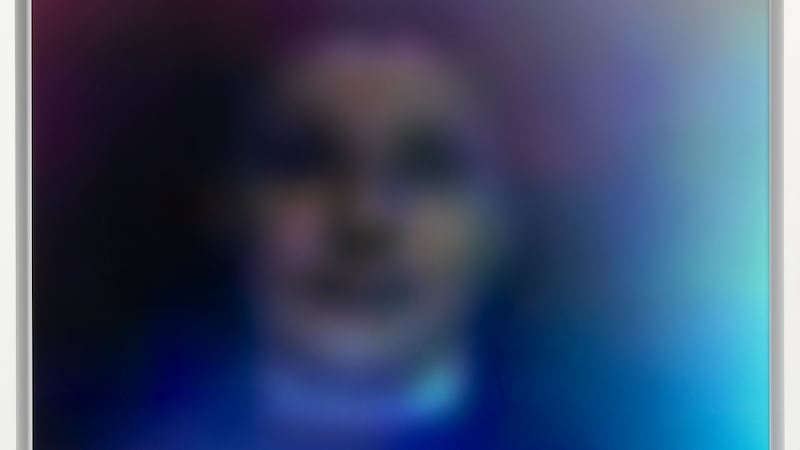As Above, So Below: Portals, Visions, Spirits & Mystics, Imma, Dublin
*****
One of numerous highlights in As Above, So Below is the inclusion of one of Bruce Nauman's first environmental sculptures, Natural Light, Blue Light Room, from 1971. The artist was totally amenable to the installation being remade for one of the rooms at Imma.
Simple, immersive and very effective, it sets a strip of ceiling-mounted blue neon lights against a strip of daylight at floor level. It is intentionally disorientating. As Nauman put it, you don’t know “what to focus on and even if you did, it would be hard to focus”.
There's an ambiguously transcendent note to the work's matter-of-factness. Co-curator Sam Thorne likens it to Nauman's 1967 piece, The True Artist Helps the World by Revealing Mystic Truths. It's a plausible aesthetic sentiment, but one also suspects that he might be having us on.
In a way the same holds true for As Above, So Below. The exhibition shuffles briskly and entertainingly through more than 100 years of spirituality in art, extending from the extraordinary paintings of Swedish artist and mystic Hilma af Klint to new, barely completed contemporary pieces fresh out of the studio.
While the transcendent impulse is there, Thorne and his co-curator, Rachel Thomas, are expressly agnostic on the question of its truth or falsehood. Also, they point out that in their survey the term spiritual is stretched to encompass not just conventional religious ideas but also various mystical and occult beliefs and practices.
Catholic spirituality is also featured. A room is given over to the work of Patrick Pye, the foremost Irish religious artist of the latter half of the 20th century, for example, and his paintings look completely at home in the context.
In particular, the ritualised formalism of his biblical compositions and his highly stylised mode of representation find echoes in the work of af Klint, and the Swiss artist and healer Emma Kunz, and other artists.
Af Klint, who lived from 1862 to 1944, was known for her fine landscape paintings. As it happens, when the idea for this show came up, Thorne had just chaired a conference on her. Following the early death of her sister, she developed an interest in spiritualism and theosophy and was involved with a group of women artists who held séances.
From 1906 she began to produce abstract paintings. But, as Thorne notes: “She did not think of them as abstract pictures as such. She felt they were guided by spirits, and she did not want them exhibited during her lifetime.”
They were more mystical diagrams than paintings to her and, even though comparable mystical ideas influenced such artists as Wassily Kandinsky and Frantisek Kupka (both represented in the show), Af Klint's work, and that of other female artists of the time, has only latterly been studied and reassessed.

It is a recurrent story. Another prime example, Ithell Colquhoun, whose work Throne became familiar with when he was director of Tate St Ives, is included. Based for much of her life in Cornwall (she died in 1988), she was a surrealist with an interest in the occult. An exceptionally accomplished painter with a distinctive personal voice, her work is well worth discovering. By way of contrast, Colquhon's subtle "mind pictures" are paired with brash new collages by artist, punk musician and activist Linder Sterling, who has long been keen on her work.
Thorne points to the show’s technological subtext. Technology and the spiritual may seem to be at opposite ends of the spectrum but they often interlink, he suggests. Kupka was among several artists intrigued by X-rays, not as a diagnostic aid but as another means, along with theosophy, of seeing beyond the visible world.
In her remarkable career, the London-based, American-born artist Liliane Lijn has consistently pushed technological boundaries – often working directly with manufacturers in pursuit of particular materials – in making her beautiful kinetic poems, cone-shaped Koans and Linear Light Columns. As with much else in this show, they are thoughtfully presented, with appropriate light and space, greatly enhancing our experience of them.
One of the strangest, most ingenious works by an Irish artist is On Exactitude in Science by Alan Butler. It centres on Godfrey Reggio's celebrated 1982 film, Koyaanisqatsi: Life Out of Balance, with Philip Glass's score. Remarkably, working with the classic interactive video game Grand Theft Auto, Butler has recreated the film, shot for shot. Watching the two running side by side, one a ghost version of the other, is unsettling, even eerie. Butler's use of video game footage as a medium, not for the first time, is inspired (his solo show, Heliosynth, is showing at Green on Red Gallery, Dublin until April 29th).
As Above, So Below is organised in four "chapters": Portals, Visions, Spirits & Mystics. In practice, divisions between them are not hard and fast, and it is not a chronological show, but it is extremely well structured and laid out, and there is real theatrical flair to the presentation.
As well as works already mentioned, there are many more surprises in store, including James Lee Byars' Diamond Floor five crystals on the floor (expressive of his concept, "Five points make a man") and Ira Cohen's phantasmagoric, hallucinogenic Mylar Chamber portrait photographs of William Burroughs et al. It provides visitors with ideal settings to explore and make their own connections between artists and ideas. There are myriad interconnections and overlaps. As Thorne observes, it can seem as if you are dealing with secret networks of people, and to some extent you are, enabling you to construct: "An alternative history of art of the last century."








